 |
Site created 12/15/97.

page updated: 1/31/05
The MGM DVD Lawsuit: Our Two Cents
| Okay...
we've been getting a lot of e-mails from readers concerned about
this DVD lawsuit against MGM. There are apparently a lot of you now
who are concerned that you may be getting ripped off by the studio
when you buy their DVDs. Relax. You're not. A bit on the lawsuit itself: Two guys have apparently sued MGM and are inviting other consumers to benefit in a class action, which MGM has settled out of court. Their lawsuit (click here for the details on the suit from the law firm's case website) argues that: "…certain representations on the label and package insert of MGM's widescreen DVDs are false and misleading because MGM's widescreen DVDs for films shot in the 1.85 to 1 aspect ratio have the same image width as MGM's standard screen format DVDs." In other words, these guys seem to think they're getting ripped off because many of MGM's 1.85:1 widescreen DVDs are nothing more than the full frame image with the top and bottom cropped off. Congratulations, guys... you've just discovered the obvious. In some cases, this is basically true. But guess what? Nobody is getting ripped off or otherwise cheated. MGM isn't involved in some massive conspiracy to cheat consumers. Wanna know why? Here's the deal: It's SUPPOSED to be that way. Let us explain... The 35mm Spherical Process 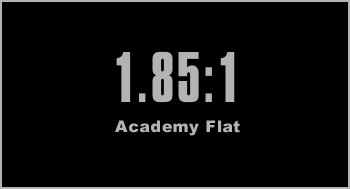 MOST widescreen films shown in theaters at the 1.85:1 aspect ratio are shot using a process called 35mm Spherical. What that means is that the physical film format is 35mm (which has an approximate aspect ratio of 1.33:1) and a "spherical" lens is mounted on the camera to capture the image being filmed without distortions. The result is basically a full frame image. However, filmmakers using this process know that they ultimately intend the film to be presented in theaters in widescreen, at a 1.85:1 aspect ratio. They compose the image on the set for widescreen... but generally take care to make sure that microphones and other production equipment don't appear in the full frame image as well. When the film is shown in theaters, a device in the projector called an aperture plate crops off the top and bottom of the full frame image, resulting in the 1.85:1 widescreen image the filmmaker intended you to see being projected on screen. When the film is transferred to video and DVD for widescreen presentation (including anamorphic widescreen for 16x9 displays), this widescreen image intended by the filmmaker is carefully preserved. BUT... when the film is transferred to video and DVD for full frame presentation (for display on regular 4x3 TVs), the entire film image, as shot in the camera, is commonly shown. Why? Well... one of the advantages of the 35mm Spherical process is that it's a good compromise - the filmmakers can carefully achieve exactly the widescreen theatrical presentation they're after, and at the same time, they can be sure that the full frame presentation meets at least some of their creative expectations as well. Most importantly, using this process generally avoids the studio having to use the dreaded "pan and scan" process when creating full frame video transfers, where only part of the widescreen image is shown at any given time. Some of you may have heard of the Super 35 process, which is favored by directors like James Cameron (he used it for Terminator 2: Judgment Day and Titanic). It works basically the same way. The captured image fills (or nearly fills) the entire frame of 35mm film, and it's then cropped for theatrical widescreen presentation. Let's show you some examples of this. [Editor's Note: ALL of the DVD images displayed below are presented as viewed on a standard, 4x3 TV for simplicity's sake.) Below you can see comparative screen captures from both the full frame and widescreen DVD versions of Dead Man Walking, Raging Bull and Get Shorty, which are all titles specifically named in this lawsuit (click here for the complete list of titles in PDF format). All three films were shown in theaters at the 1.85:1 widescreen aspect ratio and were all shot using the 35mm Spherical process (the links take you to the technical details page for each film at the Internet Movie Database to confirm this). On the left is the widescreen version. On the right is the full frame. We've added the yellow box on the full frame image to give you an idea of how the image was cropped on the top and bottom to create the widescreen version. BUT you should note here that the widescreen and full frame images are NOT exactly identical in terms of horizontal framing. This is most noticeable with the Dead Man Walking images, but they're ALL slightly different. It varies film to film, mostly for creative reasons (which, incidentally, would seem to invalidate the "same image width" argument of the lawsuit against MGM). Dead Man Walking (1995) Film Process: 35mm Spherical   Raging Bull (1980) Film Process: 35mm Spherical  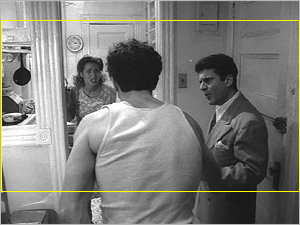 Get Shorty (1995) Film Process: 35mm Spherical  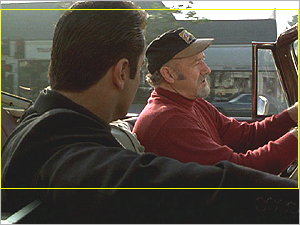 In each of the above three cases, what you're seeing in both the widescreen and full frame DVD images is exactly what you're SUPPOSED to be seeing. Just for kicks, here's another 1.85:1 title specifically named in the lawsuit - The Amityville Horror. These are screen shots from the full frame and widescreen DVDs. Both are framed as they're supposed to be. We've added the yellow box to show you what portion of the widescreen image you're seeing in the full frame image. As you can see, the horizontal framing of the two images is CLEARLY different (again, this would seem to invalidate the "same image width" part of the argument in this lawsuit). The Amityville Horror (1979) Film Process: 35mm ??  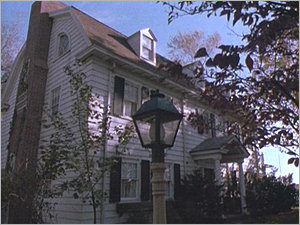 [Editor's Note: Special thanks to Bits reader Tony T. for the Dead Man Walking, Raging Bull and Amityville Horror screen shots.] Hopefully, now you understand the 35mm Spherical process. You should also now understand that while the widescreen and full frame DVDs versions of a film can SEEM to have similar image widths, they often don't. And even if they do, that doesn't mean you're being cheated. That's how it's supposed to be. Widescreen DVD Presentation The bigger concern we have here at The Digital Bits (as film purists) is that we want to make sure MGM is giving us the correct widescreen presentation (as intended by the director) on DVD. So we decided to check MGM's work on that front too, by comparing MGM's work to that of other studios on the same title. Below you can see comparative screen captures from the widescreen DVD versions of The Silence of the Lambs (released by both MGM and Criterion) and The Terminator (released by both MGM and Image Entertainment). Both are titles named in this classic action suit. Both films were shown in theaters at the 1.85:1 widescreen aspect ratio and were shot using the 35mm Spherical process (again, we've provided links to the technical details page for each film at the Internet Movie Database to confirm this). On the left is MGM's widescreen presentation (in both cases). On the right is Criterion's widescreen presentation of Silence and Image's widescreen presentation of The Terminator. As you can see, while there are very subtle differences horizontally and vertically, the presentations are basically very similar in terms of framing. The Silence of the Lambs (1991) Film Process: 35mm Spherical   The Terminator (1984) Film Process: 35mm Spherical 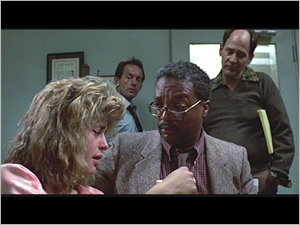 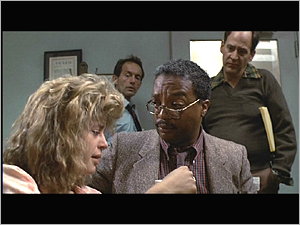 As we've noted, each film is a slightly different case. Here's another 1.85:1 title named in the lawsuit: This is Spinal Tap was filmed in 16mm and blown up to 35mm for 1.85:1 widescreen presentation in theaters. On the left is MGM's widescreen version, on the right is the previously released Criterion widescreen version. With only very subtle differences, both are basically framed identically. This is Spinal Tap (1984) Film Process: 16mm/35mm (blow-up) 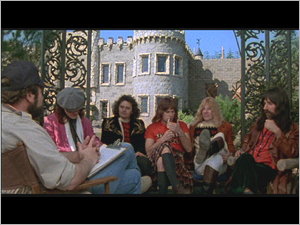  Here's another unusual case: Robocop. This film was shown in theaters at 1.85:1 widescreen and was shot using the 35mm Spherical process. MGM's widescreen DVD version is on the left, while Criterion's previously released DVD version is on the right. As you can see, there are differences in framing both vertically and horizontally (we've added a yellow box to indicate this). MGM presents the film in 1.85:1 widescreen on DVD as it was shown in theaters (they accurately note this on the packaging with the words: "1.85:1 Theatrical release format"). Criterion, on the other hand, presented the entire 1.66:1 widescreen image captured on the set (via a hard matte in-camera) - there's slightly more image area on the top and bottom on the frame, and you see a little more on the left side as well. Criterion's DVD was released before the company was doing anamorphic widescreen transfers, so 1.66:1 was used at director Paul Verhoeven's request. MGM's transfer is anamorphic. Still, these differences aside, it's important to note that BOTH MGM and Criterion have presented the film "correctly". Robocop (1987) Film Process: 35mm Spherical (hard matte to 1.66:1 in-camera)  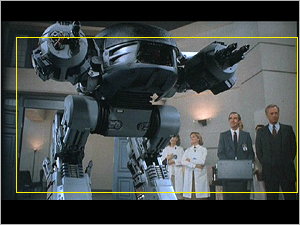 Okay, you should get the idea now. We've obviously only looked at a few examples, but near as we can determine MGM is doing a decent job of presenting its widescreen films on DVD. Conclusions We can't speak to every film on the MASSIVE list of titles that are specified in this lawsuit. We will say this however: There are plenty of films that just plain don't belong on this list. For example, some (like Bill & Ted's Excellent Adventure) are 2.35:1 aspect ratio films, not 1.85:1. Others (like Killer Klowns from Outer Space) have never been released on DVD in full frame - Klowns is only available in widescreen. And, to our knowledge, both Remo Williams and The Dark Half have ONLY been released on full frame on DVD. Why any of them (and there are likely others as well) should be named in this suit escapes us. Keep in mind again that we're not going to speak to the plaintiffs' argument that "certain representations on the label and package insert of MGM's widescreen DVDs are false and misleading." To our thinking, MGM's DVD aspect ratio labeling has always been pretty clear, but that's just our opinion. Maybe the labeling IS occasionally technically slightly inaccurate or misleading (to those who don't understand the technical workings of film). This seems really to be the grounds upon which MGM agreed to the settlement. Look... we're not lawyers, and we're certainly not making any legal claims. But people are NOT getting cheated here. And to make people think they are getting cheated, and to invite them to sue over it, seems to us to be something of an abuse of the legal system. Much like suing a restaurant because you got burned by their coffee which you apparently didn't know was supposed to be hot... despite the fact that it said "hot coffee" on the cup. Anyway, we aren't talking about this here to support MGM, although from our vantage point this whole lawsuit seems pretty damn silly. We're doing it because there are a LOT of folks out there who don't fully understand the way films are shot and presented in theaters and on DVD. Given that, many people have heard about this lawsuit and suddenly started to believe that MGM has been cheating them, and that lots of their widescreen MGM DVDs are somehow defective. Rest assured, folks... YOU ARE NOT BEING RIPPED OFF. Specific cases aside, to the best of our knowledge, MGM is giving you its 1.85:1 films on DVD in both widescreen and full frame correctly. So you can relax now. Breathe deeply and enjoy your discs with a light heart. To quote a some of the e-mails we've been getting lately: "Hey... these guys suing MGM have a point! The widescreen and full frame versions on some of my MGM DVDs ARE the same width!" Yep... sometimes they are. But you still aren't getting cheated. Hopefully, we've put your minds at ease. That's what we're here for. ;-) Bill Hunt, Editor The Digital Bits billhunt@thedigitalbits.com For more information on the 35mm Spherical process, we recommend that you visit: Widescreen Cinema: A History and Review of Widescreen Systems at The Blurred Horizon website, written by Thomas E. Brown. Specifically, check out sections IV. Flat Widescreen and IX. Aspect Ratios and TV / Home Video (the latter starting with the text: "A different situation occurs in movies made in masked 35mm or Super 35."). There may be other good explanations of the 35mm Spherical process online. We'd be happy to link to a few more of them here if you e-mail them in. |
 |
| Site
designed for 1024 x 768 resolution, using 16M colors and .gif 89a
animation. © 1997-2015 The Digital Bits, Inc., All Rights Reserved. billhunt@thedigitalbits.com |